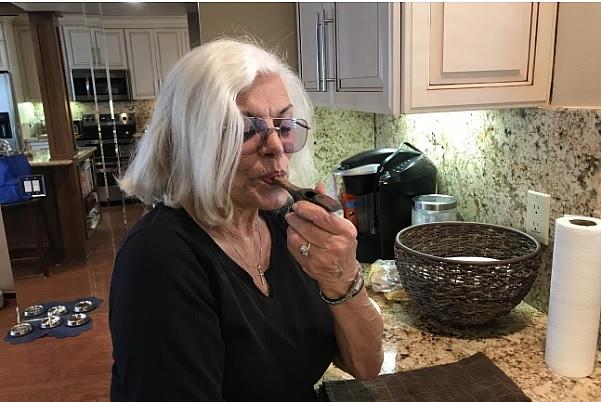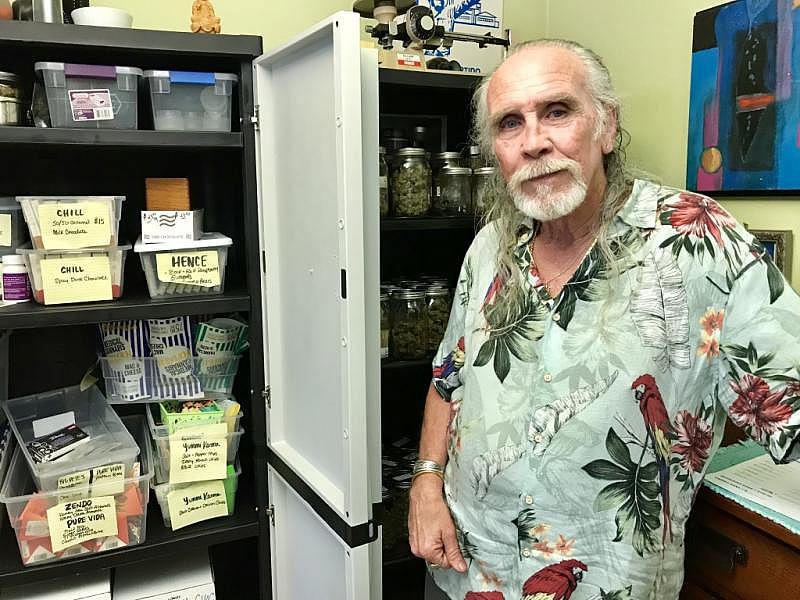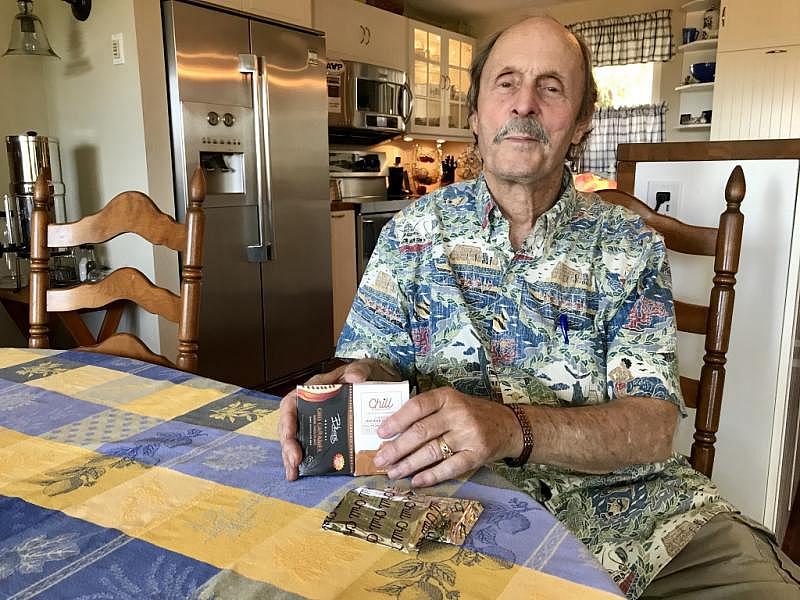Is pot the answer to keeping seniors in pain off opioids and other prescription drugs?
This story was produced as a project for USC Annenberg's Center for Health Journalism California Fellowship.
Other stories in the series include:
Is the crackdown on opioids failing patients?
How ER docs could play a key role in fighting the opioid epidemic

Linda Tisbo, a member of the Laguna Woods Medical Cannabis Collective, cleans out her pipe on April 11, 2018. The collective has more than 800 members
Arlene Brown, an 84-year-old resident of Laguna Woods, suffers from severe back and nerve pain caused by spinal stenosis and herniated disks. She needs a walker to get around.
Last fall, Brown landed in the emergency room. She says she had a bad reaction to increasing doses of gabapentin, which is sometimes used to treat chronic pain.
"I hallucinated one morning after having gabapentin that night and when I woke up, I couldn't move my legs and I was screaming," she says.
Brown spent a month in a nursing home while doctors weaned her off the drug. Now she does physical therapy and rubs a cannabis-infused cream on her body when she feels pain. She calls it "liquid gold."
Seniors like Brown are among the heaviest users of prescription drugs in the U.S.
And that usage has skyrocketed in recent years: Four out of 10 seniors aged 65 years and over take five or more prescription drugs, according to the Centers for Disease Control and Prevention. That's about three times as manyas 20 years ago.
There’s no question pharmaceuticals help many seniors live longer and better lives. Still, some experts have begun to worry that seniors are on too many drugs, especially opioid painkillers.
The U.S. Department of Health and Human Services says one out of every three Medicare Part D beneficiaries got an opioid prescription in 2016. Most of the more than 46 million enrollees are seniors.
"Although beneficiaries may receive opioids for legitimate purposes, these high amounts raise concern," the agency’s inspector general said in a report.
The watchdog noted that seniors who use opioids long-term are at increased risk of falls and fractures.
Researchers have also found that in states where medical marijuana is legal, there are fewer opioid-related overdoses and fewer prescriptions for pain pillswritten for Medicare enrollees.
In Laguna Woods Village, the 55-and-over retirement community where Brown lives, these issues have played out in dramatic ways.
The gated complex occupies most of the small Orange County city of Laguna Woods. In recent years, the city has had one of the highest rates of opioid-related overdose deaths in Orange County.
Some seniors there now say they are looking for ways to take as few prescription drugs as possible. And many are turning to cannabis as an alternative.
They have a supplier right in town: the Laguna Woods Medical Cannabis Collective.
THE MAN BEHIND THE MARIJUANA
Lonnie Painter, founder and director of the Laguna Woods Medical Cannabis Collective, at his home in Laguna Woods, April 11, 2018.
Lonnie Painter has been running the collective for nearly 10 years. In a community of around 16,000, the collective has more than 800 members on the books, although Painter concedes some may have died or moved away.
Still, the collective’s hefty roster speaks to its popularity among seniors, many of whom are looking for ways to manage chronic pain, insomnia and a wide range of other medical problems.
On a recent morning, Painter was at the home of Linda and Michael Tisbo. He’s there with his assistant Cat McCormick who helps Painter run the collective.
Linda Tisbo is a former singer. She and her husband now spend their evenings entertaining family and friends at home and attending social events put on by the village’s dozens of clubs.
The Tisbos sit on the couch while Painter perches on the edge of a wooden chair — he has back problems, he explains. A former chef and restaurant owner, Painter sports thinning gray hair that reaches down to his armpits. He wears two metal bracelets on each arm and rings on six of his fingers.
He begins to ask Linda questions.
"Is the problem mostly anxiety?" Painter asks.
"No. My problem is that I don't sleep good," Tisbo says. Her husband quips about her mind being too busy to sleep.
The 81-year-old, with platinum white hair and obvious spunk, uses cannabis principally to help her relax at bedtime.
At his apartment a short distance from the Tisbos, another collective member, Jon Northrop, checks on the cannabis seeds he recently planted on the back porch of his apartment. Three have sprouted.
The 74-year-old walks slowly and holds the railing for support. He deals with severe chronic pain.
This is how he describes the pain: "From the mid-shin down, it's like somebody took a wire brush and then torched it."
Northrop has had numerous back surgeries since a head-on car crash 25 years ago. And he has multiple sclerosis.
Northrop’s pain reliever of choice is a cannabis-infused dark chocolate Chill bar. He eats two squares every evening to ease the pain and help him sleep. Not only is the pain gone within two hours of eating the chocolate, says Northrop, but he usually wakes up the next morning pain-free.
Jon Northrop, 74, uses cannabis to relieve pain stemming from multiple sclerosis and a series of back injuries. His product of choice is a cannabis-infused chocolate bar, which he eats —but only two squares — before bedtime.
There's a dearth of medical research on cannabis, but some studies have shown it has potential to treat chronic pain.
Back at the Tisbos, Painter gives the couple a short lecture on terpenes, the chemical compounds found in cannabis (and many other plants) that are thought to provide therapeutic benefits.
Afterwards, he sees himself out, leaving McCormick to dispense the cannabis and instruct Linda Tisbo on how to use it for the maximum desired effect.
Tisbo pulls a small food processor out of a cupboard and, following McCormick's instructions, she blends together several fat cannabis flowers of different strains. McCormick says the concoction should help Tisbo sleep.
"I'll smoke this tonight before I go to bed, instead of taking a sleeping pill," Tisbo says, shaking the coarsely ground weed into a ziplock bag. She writes "PM" on the bag with a Sharpie, and then, just in case she forgets, she adds "sleep."
THE COLLECTIVE'S UNCERTAIN FUTURE
Until recently, Painter did most of the work himself to keep the medical marijuana collective running, including consulting with new patients, ordering cannabis flower, topical creams and marijuana-laced edible goodies — even extracting cannabis oil from the plant to make remedies. The collective tests all of the products sold to its members.
Lonnie Painter collects antique opioid- and cannabis-based tinctures. The large tin is from an experimental federal program that provides marijuana pre-rolls to selected patients around the country.
During the early years of the collective, Painter says he even grew pot in the Laguna Woods Village community garden, until the management caught wind and made him stop. He also says he’s spent thousands of hours reading studies about the medical uses of cannabis and attending courses and conferences.
But Painter, who is 72, has slowed down. "I've been doing this for so long now, I'm tired, you know,” he says.
Plus, under California’s new pot laws, medical marijuana collectives must apply for and receive state licenses by the end of the year in order to continue operating legally. Getting a state license requires a local permit first, and the city of Laguna Woods officially outlawed cannabis businesses last year, leaving the local collective’s future uncertain.
Painter worries what will happen to his fellow seniors if the collective dissolves.
“That's one of the reasons why I'd even consider keep doing this. When we're gone, who do they turn to? The dispensaries? Budtenders? They don't know anything,” Painter says disdainfully, “and it's all for profit.”
In the meantime, he’s training other collective members to be medical cannabis consultants, to help their peers manage the ailments of aging.
[This story was originally published by KPCC.]
[Photos by Jill Replogle / KPCC.]

